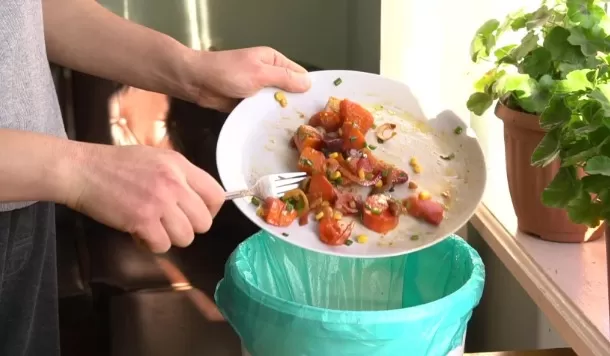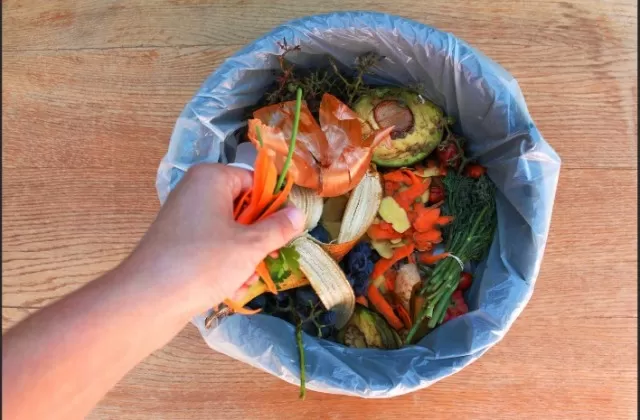Extend Your Green Thumb to Winter with a Garden Tower. The holiday season often brings a mix of joy and indulgence, but it doesn’t have to lead to excessive spending and wastefulness.
By staying organized and being mindful of common holiday pitfalls, you can save money and significantly reduce food waste. By embracing these practical strategies, you can navigate the holiday season with financial prudence and environmental consciousness. Saving money and reducing food waste not only benefit your wallet and the planet but also contribute to a more mindful and enjoyable holiday experience for you and your loved ones.
Minimizing Waste: Practical Steps to Cut Down on Excess and Save Resources

The National Resources Defense Council brought to light a concerning revelation – a staggering 40 percent of America’s food was being discarded, adding to the mounting waste crisis.
The situation worsened during the holiday season, particularly between Thanksgiving and New Year’s, when households across the U. S.
generated an astounding 5 million tons of additional food waste compared to other times of the year. While the holiday spirit often revolves around abundance and celebrations, it’s essential to recognize that we can still revel in the festivities while being mindful of our consumption patterns.
There are numerous ways to take action and significantly reduce waste while also reaping the benefits of saving money.
Extending the scope beyond just food waste, it becomes evident that the waste problem stretches into other aspects of our lives.
Excessive packaging, single-use plastics, and the throwaway culture further contribute to the environmental burden. As we continue to witness the devastating impacts of waste on our planet, it becomes imperative for individuals and communities to adopt sustainable practices.
Thankfully, small yet meaningful changes in our daily routines can have a substantial impact.
By making conscious choices, such as opting for reusable bags, containers, and water bottles, we can significantly reduce our reliance on disposable items. Embracing the principles of reduce, reuse, and recycle can lead to substantial waste reduction in our homes and workplaces.
Furthermore, initiatives like composting can not only divert organic waste from landfills but also enrich the soil for greener gardens and sustainable agriculture.
Collaborating with local organizations and participating in community-driven recycling programs can also play a vital role in promoting responsible waste management.
Additionally, as technology advances, innovative solutions like food sharing apps, smart appliances, and waste-to-energy systems present promising opportunities to curb waste generation and enhance resource efficiency.
In conclusion, the task of reducing waste may seem daunting, but with a collective effort and individual commitment, we can pave the way for a cleaner, more sustainable future.
By addressing waste in all its forms and striving to make mindful choices, we not only contribute to the well-being of our environment but also save money and set a positive example for generations to come. So, let’s join hands and take the journey towards a waste-free world.
The Pitfalls of Unplanned Shopping: Avoiding Food Waste and Overspending
In the bustling aisles of the grocery store, the unprepared shopper may find themselves caught in a web of impulse-buying and unnecessary purchases.
Without a well-thought-out plan, food waste becomes a lurking menace, and overspending on items you don’t truly need becomes all too common.
The first step to combat this challenge is to establish a clear understanding of what you genuinely require and what essentials you already have stocked in your fridge and pantry.
By taking a thorough inventory beforehand, you can create a detailed shopping list that serves as a compass during your store visit, guiding you toward making informed decisions.
It’s no secret that supermarkets often lure shoppers with enticing sales and deals, tempting them to buy more than they actually need.
The appeal of discounts and “buy one, get one free” offers can lead to accumulating excess items, only to realize later that they may go unused and end up in the trash.
While these offers might seem like a good way to save money, the hidden cost lies in the potential food waste they generate.
Overbuying perishable items often leads to them expiring before they can be consumed, squandering both food and money.
To avoid falling into this shopping trap, it’s crucial to stick to your prepared list and resist the urge to make impromptu purchases.
By doing so, you not only minimize the risk of food waste but also gain control over your budget, ensuring that your hard-earned money is spent on items you truly need and will utilize effectively.
Moreover, shopping without a list can also mean overlooking essential items, leading to last-minute return trips to the store and further exacerbating the issue of wasted time, money, and Resources.
In conclusion, organized and mindful grocery shopping is the key to reducing food waste and preventing unnecessary expenditures.
A well-planned list helps you stay focused on your requirements and prevents the allure of impulse-buying from steering you off course. By adopting a thoughtful and intentional approach to shopping, you not only contribute to a more sustainable environment but also enhance your own financial well-being.
So, the next time you venture into the aisles of the supermarket, remember: a list in hand keeps waste at bay!.
Transforming Food Scraps into Culinary Treasures: Embracing the Art of Repurposing

During the festive season, as we gather to prepare hearty holiday meals, it’s no surprise that an abundance of food scraps finds its way into the trash.
However, it’s time to shed light on the hidden potential of these seemingly disposable remains. Many of the items we tend to discard can actually be ingeniously repurposed to elevate the flavors of future culinary creations.
By unlocking the culinary magic hidden within onion skins, carrot tops, herb stems, leafy green leftovers, and even turkey bones, we can create a delightful and nutritious soup stock that embodies sustainability and resourcefulness.
Instead of hastily discarding onion skins, consider adding them to your stockpot.
They infuse the broth with a subtle, earthy sweetness that enhances the overall taste of your soups and stews. Similarly, the vibrant greens from carrot tops and stems of herbs like parsley, cilantro, and dill contribute unique flavors and valuable nutrients.
These often-overlooked parts can be the secret to creating a stock that’s rich in taste and goodness.
Don’t overlook the potential of turkey bones either.
After the feast, gather these remnants and simmer them with your collection of vegetable scraps to produce a savory broth. The leftover turkey bits clinging to the bones will further enrich the stock with a hint of holiday memories.
To make the most of these invaluable scraps, you need not use them immediately.
Instead, gather them in a container and store them in the freezer, preserving their flavors and nutrients for a later culinary adventure. When you’re ready to embark on a stock-making journey, simply take out your frozen treasure trove of scraps and let them simmer to perfection.
By embracing the art of repurposing food scraps, not only do we significantly reduce food waste but we also honor the concept of nose-to-tail and root-to-leaf cooking.
This mindful approach pays tribute to the entirety of the ingredients we use, celebrating their various components and appreciating the gifts they bestow upon us.
So, this holiday season and beyond, let’s embrace the transformation of food scraps into culinary treasures.
Let’s savor the essence of sustainability and creativity, turning what was once destined for the trash into flavorful, nutrient-rich soup stocks that nourish both body and soul.
Harnessing the Power of Multitasking Ingredients: A Recipe for Reducing Food Waste
As the holiday season unfolds, kitchens come alive with the aroma of special dishes crafted from unique ingredients that may not see much use during the rest of the year.
However, this culinary adventure often carries the risk of generating food waste when we find ourselves with leftover portions of ingredients we won’t immediately use again. The key to overcoming this challenge lies in unlocking the multitasking potential of these ingredients, ensuring that no edible treasures end up in the garbage.
Take, for instance, the humble can of pumpkin puree, often reserved for the seasonal delight of a pumpkin pie.
While the recipe may require only half the can, the other half need not meet a premature fate in the trash. Instead, we can let this multitasking ingredient shine by transforming it into delightful pumpkin muffins, perfect for a joyous holiday brunch.
By doing so, we not only extend the life of the pumpkin puree but also create a new culinary delight that brings additional joy to our gatherings.
This concept of ingredient multitasking becomes a powerful tool in our efforts to reduce food waste.
When planning holiday menus, consider how you can use various ingredients in multiple dishes. For instance, if a recipe calls for fresh herbs like rosemary or thyme, think about incorporating them into multiple dishes to ensure their full utilization.
The same applies to other perishable ingredients that might be leftover, like vegetables or fruits. By incorporating them creatively into different meals, we minimize waste while maximizing flavor and variety.
Moreover, don’t underestimate the value of freezing ingredients for later use.
If you find yourself with more leftover ingredients than you can use immediately, store them in the freezer to be repurposed in future meals. Whether it’s extra sauce, broth, or chopped vegetables, these frozen treasures can save you time and money down the line while also reducing waste.
By making our ingredients multitask, we embark on a journey of culinary ingenuity and sustainability.
We embrace the joy of creating diverse and delicious dishes while minimizing our impact on the environment. Together, let’s savor the flavors of the holidays while celebrating the art of resourceful cooking and ensuring that no edible delight goes to waste.
Right-Sizing Your Feast: Avoiding Excess Food and Embracing Thoughtful Meal Planning

As a gracious host, it’s only natural to want to ensure that your guests feel abundantly nourished and satisfied during special gatherings.
However, there’s a fine line between ensuring everyone’s well-fed and preparing an excessive feast that leads to an overwhelming surplus of leftovers. The key to striking this balance lies in adopting a mindful and organized approach to meal planning.
One effective way to prevent overcooking is to utilize free planning tools readily available to help you tailor your meals according to the number of guests you’ll be hosting.
By using these tools, you can accurately gauge the right portion sizes and quantities, allowing you to serve your loved ones with precision and care.
While a grand, full turkey may seem like the centerpiece of a perfect Thanksgiving tablescape, it’s essential to consider the actual needs of your gathering.
Smaller families or intimate gatherings might find greater satisfaction in preparing turkey breasts instead, which not only reduces food waste but also minimizes cooking time. Alternatively, exploring other options, like a more modestly sized bird such as a chicken, can be equally delicious and appropriate for the occasion.
Being mindful of the number of guests you’ll be serving doesn’t mean sacrificing the quality or appeal of your meals.
On the contrary, it opens up opportunities for creativity and resourcefulness. Rather than overstretching the menu with an excess of dishes, focus on preparing a few well-curated options that showcase the essence of the occasion and cater to the preferences of your guests.
Moreover, embracing the idea of embracing leftovers in your planning can lead to exciting culinary adventures in the days following the gathering.
Plan for a selection of dishes that can be easily transformed or repurposed into new and exciting creations, allowing your guests to enjoy the flavors of the celebration for days to come.
In conclusion, right-sizing your feast is about striking a harmonious balance between hospitality and practicality.
By thoughtfully planning your meals and considering the needs of your guests, you can create a memorable culinary experience without unnecessary waste. So, as you prepare for your next gathering, remember that less can indeed be more when it comes to both creating cherished memories and honoring the planet with responsible dining.
*The information is for reference only.